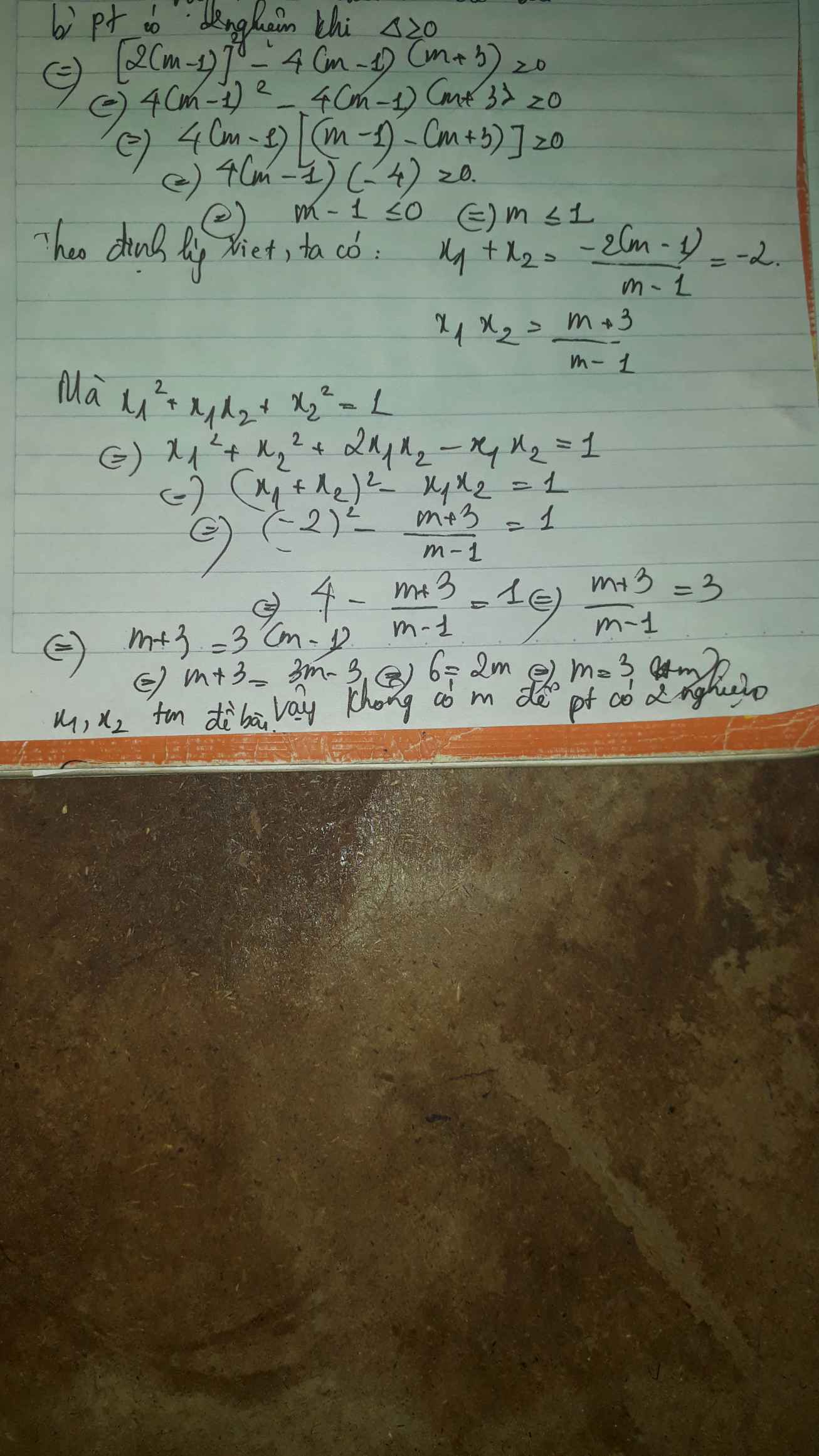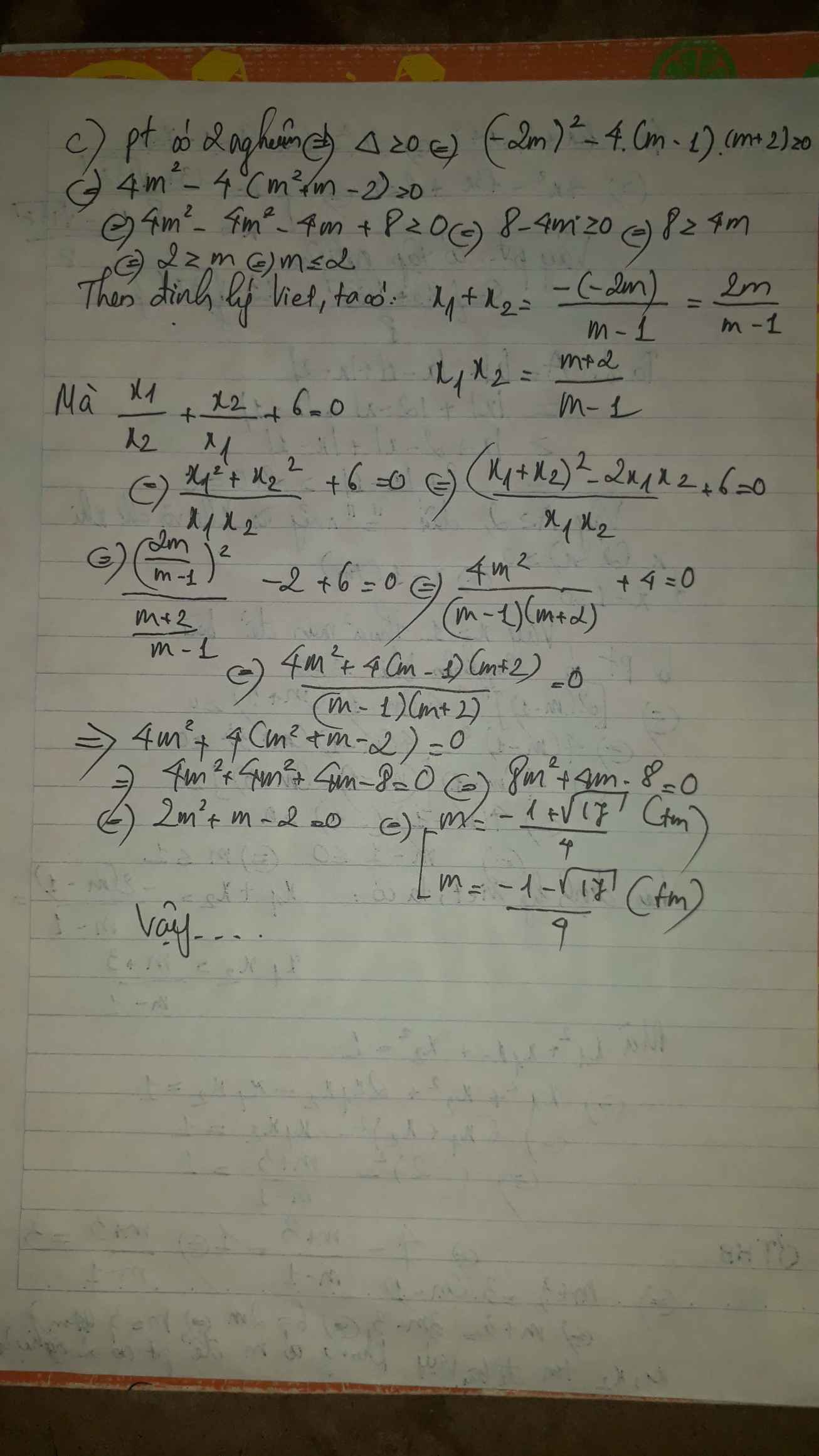Định m để phương trình \(\left(m-2\right)x^2-2\left(m-1\right)x+m-3=0,\left(m\ne2\right)\) có nghiệm \(x_1;x_2\), và thiết lập hệ thức giữa các nghiệm độc lập đối với m.

Những câu hỏi liên quan
b Tìm m để phương trình left(m-1right)x^2+2left(m-1right)x+m+30 có hai nghiệm x1,x2 thỏa mãn x_1^2+x_1.x_2+x_2^21c Tìm m để phương trình left(m-1right)x^2-2mx+m+20 có hai nghiệm x1,x2 phân biệt thỏa mãn dfrac{x_1}{x_2}+dfrac{x_2}{x_1}+60d Tìm m để phương trình 3x^2+4left(m-1right)x+m^2-4m+10 có hai nghiệm phân biệt x1,x2 thỏa mãn dfrac{1}{x_1}+dfrac{1}{x_2}dfrac{1}{2} (x1+x2)
Đọc tiếp
b Tìm m để phương trình \(\left(m-1\right)x^2+2\left(m-1\right)x+m+3=0\) có hai nghiệm x1,x2 thỏa mãn \(x_1^2+x_1.x_2+x_2^2=1\)
c Tìm m để phương trình \(\left(m-1\right)x^2-2mx+m+2=0\) có hai nghiệm x1,x2 phân biệt thỏa mãn \(\dfrac{x_1}{x_2}+\dfrac{x_2}{x_1}+6=0\)
d Tìm m để phương trình \(3x^2+4\left(m-1\right)x+m^2-4m+1=0\) có hai nghiệm phân biệt x1,x2 thỏa mãn \(\dfrac{1}{x_1}+\dfrac{1}{x_2}=\dfrac{1}{2}\) (x1+x2)
b) phương trình có 2 nghiệm \(\Leftrightarrow\Delta'\ge0\)
\(\Leftrightarrow\left(m-1\right)^2-\left(m-1\right)\left(m+3\right)\ge0\)
\(\Leftrightarrow m^2-2m+1-m^2-3m+m+3\ge0\)
\(\Leftrightarrow-4m+4\ge0\)
\(\Leftrightarrow m\le1\)
Ta có: \(x_1^2+x_1x_2+x_2^2=1\)
\(\Leftrightarrow\left(x_1+x_2\right)^2-2x_1x_2=1\)
Theo viet: \(\left\{{}\begin{matrix}x_1+x_2=-\dfrac{b}{a}=2\left(m-1\right)\\x_1x_2=\dfrac{c}{a}=m+3\end{matrix}\right.\)
\(\Leftrightarrow\left[-2\left(m-1\right)^2\right]-2\left(m+3\right)=1\)
\(\Leftrightarrow4m^2-8m+4-2m-6-1=0\)
\(\Leftrightarrow4m^2-10m-3=0\)
\(\Leftrightarrow\left[{}\begin{matrix}m_1=\dfrac{5+\sqrt{37}}{4}\left(ktm\right)\\m_2=\dfrac{5-\sqrt{37}}{4}\left(tm\right)\end{matrix}\right.\Rightarrow m=\dfrac{5-\sqrt{37}}{4}\)
Đúng 1
Bình luận (1)
cho phương trình \(\left(m+1\right)x^2-2\left(m+1\right)x+m-3=0\)
a, giải phương trình khi m = 3
b, tìm m để phương trình có 2 nghiệm phân biệt \(x_1;x_2\)thoả mãn \(\left(4x_1+1\right)\left(4x_2+1\right)=18\)
a, Thay m vào pt ta được :
(3+1).x2-2(3+1).x+3-3=0
\(\Leftrightarrow\)4x2-8x=0
\(\Leftrightarrow4x\left(x-2\right)=0\)
\(\Leftrightarrow\left[{}\begin{matrix}x=0\\\\x-2=0\end{matrix}\right.\)
\(\Leftrightarrow\left[{}\begin{matrix}x=0\\x=2\end{matrix}\right.\)
Vậy m=3 phương trình có 2 nghiệm là 0 và 2
b, Theo Vi et ta có :
\(\left\{{}\begin{matrix}x_1.x_2=\dfrac{m-3}{m+1}\\x_1+x_2=\dfrac{2\left(m+1\right)}{m+1}\end{matrix}\right.\left(vớim\ne-1\right)\)
\(\Leftrightarrow\left\{{}\begin{matrix}x_1.x_2=\dfrac{m-3}{m+1}\\x_1+x_2=2\end{matrix}\right.\) (1)
Ta có : (4x1+1)(4x2+1)=18
\(\Leftrightarrow16x_1.x_2+4x_1+4x_2+1=18\)
\(\Leftrightarrow16.x_1.x_2+4\left(x_1+x_2\right)=17\) (2)
Thay (1) vào (2) ta được :
16.\(\dfrac{m-3}{m+1}+4.2=17\)
\(\Leftrightarrow\dfrac{16m-48}{m+1}=9\)
\(\Leftrightarrow9\left(m+1\right)=16m-48\)
\(\Leftrightarrow9m+9=16m-48\)
\(\Leftrightarrow7m=57\)
\(\Leftrightarrow m=\dfrac{57}{7}\) (thỏa mãn m\(\ne-1\))
Vậy ..
Đúng 2
Bình luận (0)
Tìm m để phương trình \(x^2-2\left(m+1\right)x+m^2+m=0\) có hai nghiệm \(x_1,x_2\) thỏa mãn:
a \(x_1+x_2=x_1x_2\)
b \(3\left(x_1+x_2\right)-2x_1.x_2=1\)
\(\Delta'=\left[-\left(m+1\right)\right]^2-\left(m^2+m\right)=m^2+2m+1-m^2-m\)
\(=m+1\)
pt có nghiệm x1,x2 \(< =>m+1\ge0< =>m\ge-1\)
vi ét \(=>\left\{{}\begin{matrix}x1+x2=2m+2\\x1x2=m^2+m\end{matrix}\right.\)
a,\(=>2m+2=m^2+m< =>m^2-m-2=0\)
\(a-b+c=0=>\left[{}\begin{matrix}m1=-1\\m2=2\end{matrix}\right.\left(tm\right)\)
b,\(< =>3\left(2m+2\right)-2\left(m^2+m\right)-1=0\)
\(< =>-2m^2+4m+5=0\)
\(ac< 0\) pt có 2 nghiệm pbiet \(=>\left[{}\begin{matrix}m1=...\\m2=...\end{matrix}\right.\) thay số vào tính m1,m2 đối chiếu đk
Đúng 1
Bình luận (0)
cho phương trình :
\(x^2-mx-3=0\)
a.giải phương trình khi m = -2
b.tìm m để phương trình có 1 nghiệm là 3.Tìm nghiệm còn lại.
c.tìm m để phương trình có 2 nghiệm \(x_1,x_2\) thỏa mãn \(\left(x_1+5\right).\left(x_2+5\right)=2022\)
a, bạn tự làm
b, Thay x = 3 vào pt trên ta được
\(9-3m-3=0\Leftrightarrow6-3m=0\Leftrightarrow m=2\)
Thay m = 2 vào ta được \(x^2-2x-3=0\)
Ta có a - b + c = 1 + 2 - 3 = 0
vậy pt có 2 nghiệm x = -1 ; x = 3
c, \(\Delta=m^2-4\left(-3\right)=m^2+12>0\)
vậy pt luôn có 2 nghiệm pb
\(x_1x_2+5\left(x_1+x_2\right)-1997=0\)
\(\Rightarrow-3+5m-1997=0\Leftrightarrow5m-2000=0\Leftrightarrow m=400\)
Đúng 1
Bình luận (0)
Chi phương trình \(^{x^2-x+m=0}\)(1)
tìm m để phương trình (1) có 2 nghiệm phân biệt \(_{x_1;x_2}\)thỏa mãn
\(\left(x_1^2+x_2+m\right)\)\(\left(x_2^2+x_1+m\right)\)= \(m^2\)-m -1
giúp mik vs ạ :((
Cho phương trình \(x^2\)+3x+m-1=0 ( x là ẩn)
a) giải ptr vs m=3
b) Định m để phương trình có 2 nghiệm x1,x2 thỏa mãn:
\(x^2_1.\left(x_1^4-1\right)+x_2.\left(32x^4_2-1\right)=3\)
\(x^2+3x+m-1=0\left(1\right)\)
Thay \(m=3\) vào \(\left(1\right)\)
\(\Rightarrow x^2+3x+3-1=0\)
\(\Rightarrow x^2+3x+2=0\)
\(\Rightarrow x^2+x+2x+2=0\)
\(\Rightarrow x\left(x+1\right)+2\left(x+1\right)=0\)
\(\Rightarrow\left(x+2\right)\left(x+1\right)=0\)
\(\Rightarrow\left[{}\begin{matrix}x+2=0\\x+1=0\end{matrix}\right.\)
\(\Rightarrow\left[{}\begin{matrix}x=-2\\x=-1\end{matrix}\right.\)
Vậy \(S=\left\{-2;-1\right\}\) khi \(m=3\)
Đúng 0
Bình luận (2)
Tìm m để phương trình \(\left(m+1\right)x^2-2\left(m-1\right)x+m^2+4m-5=0\) có đúng hai nghiệm \(x_1,x_2\) thỏa mãn \(2< x_1< x_2\) .
cho phương trình\(x^2-\left(2m+1\right)x+m^2-m=0\) tìm các giá tri của m để phương trình có hai nghiệm phân biệt x1,x2 thỏa mãn điều kiện:\(\left(x_1^2+mx_1+x_2-m^2+m\right)\left(x_2^2+mx_2+x_1-m^2+m\right)=-9\)
Cho phương trình \(x^2-2\left(m+1\right)x+m^2+4=0\) (m là tham số). Tìm m để phương trình có 2 nghiệm \(x_1,x_2\) thỏa mãn \(x_1^2+2\left(m+1\right)x_2=3m^2+16\)
\(\Delta=\left[-2\left(m+1\right)\right]^2-4\left(m^2+4\right)\)
\(=4m^2+8m+4-4m^2-16\)
\(=8m-12\)
Để pt có 2 nghiệm thì \(\Delta>0\)
\(\Leftrightarrow8m-12>0\Leftrightarrow m>\dfrac{3}{2}\)
Theo hệ thức Vi-ét,ta có: \(\left\{{}\begin{matrix}x_1+x_2=2\left(m+1\right)\left(1\right)\\x_1x_2=m^2+4\end{matrix}\right.\)
\(\left(1\right)\rightarrow x_2=2\left(m+1\right)-x_1\)
\(x_1^2+2\left(m+1\right)x_2=3m^2+16\)
\(\Leftrightarrow x_1^2+2\left(m+1\right)\left[2\left(m+1\right)-x_1\right]=3m^2+16\)
\(\Leftrightarrow x_1^2+4\left(m+1\right)^2-2x_1\left(m+1\right)=3m^2+16\)
\(\Leftrightarrow x_1^2+4m^2+8m+4-2x_1\left(m+1\right)=3m^2+16\)
\(\Leftrightarrow x_1^2+m^2+8m-12-2x_1\left(m+1\right)=0\)
\(\Leftrightarrow x_1^2+m^2+8m-12-x_1\left(x_1+x_2\right)=0\)
\(\Leftrightarrow x_1^2+m^2+8m-12-x_1^2-x_1x_2=0\)
\(\Leftrightarrow m^2+8m-12-m^2-4=0\)
\(\Leftrightarrow m^2+8m-16=0\)
\(\Leftrightarrow\left[{}\begin{matrix}m=-4+4\sqrt{2}\left(tm\right)\\m=-4-4\sqrt{2}\left(ktm\right)\end{matrix}\right.\)
Vậy \(m=\left\{-4+4\sqrt{2}\right\}\)
Đúng 1
Bình luận (0)























